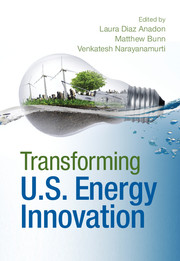Book contents
- Frontmatter
- Contents
- 1 The Need to Transform U.S. Energy Innovation
- 2 Expanding and Better Targeting U.S. Investment in Energy Innovation: An Analytical Approach
- 3 Reforming U.S. Energy Innovation Institutions: Maximizing the Return on Investment
- 4 Encouraging Private Sector Energy Technology Innovation and Public–Private Cooperation
- 5 Maximizing the Benefit from International Cooperation in Energy Innovation
- 6 Transforming U.S. Energy Innovation: How Do We Get There?
- Index
- References
6 - Transforming U.S. Energy Innovation: How Do We Get There?
Published online by Cambridge University Press: 05 August 2014
- Frontmatter
- Contents
- 1 The Need to Transform U.S. Energy Innovation
- 2 Expanding and Better Targeting U.S. Investment in Energy Innovation: An Analytical Approach
- 3 Reforming U.S. Energy Innovation Institutions: Maximizing the Return on Investment
- 4 Encouraging Private Sector Energy Technology Innovation and Public–Private Cooperation
- 5 Maximizing the Benefit from International Cooperation in Energy Innovation
- 6 Transforming U.S. Energy Innovation: How Do We Get There?
- Index
- References
Summary
As we argued in Chapter 1, the United States and the world need a radical acceleration in the rate of energy technology innovation to meet the profound economic, environmental, and national security challenges that energy poses in the 21st century. If the U.S. government does not act now to improve the conditions for innovation in energy, even in times of budget stringency, it risks losing leadership in one of the key global industries of the future, and the world risks being unable to safely mitigate climate change and to reduce vulnerability to disruptions and conflicts – both domestic and international. Waiting is not an option.
The previous chapters of this book have laid out a broad agenda of policy changes that could help cause such a transformation in U.S. energy innovation. We believe that implementing these recommendations would bring the United States much closer to meeting the CASCADES criteria for an effective energy technology innovation strategy that we laid out in Chapter 1 – an approach that is comprehensive, adaptable, sustainable, agile, diversified, equitable, and strategic. In this chapter, we summarize the recommendations of the previous chapters, build on crosscutting themes that run through them all, and offer a preliminary discussion of the steps that would be needed to put the United States on the trajectory we suggest.
A Major Expansion in Energy Technology Innovation Investments, with More Stability and Better Targeting
As discussed in Chapter 2, the U.S. government should improve its approach to making decisions about energy RD&D investments in different technology areas. We have developed an approach to support these decisions and concluded that dramatically expanding the Department of Energy (DOE)'s investment in energy research, development, and demonstration (RD&D), focused on a broad portfolio of different energy technologies and stages of innovation, is justified by the expected social benefits.
- Type
- Chapter
- Information
- Transforming US Energy Innovation , pp. 216 - 232Publisher: Cambridge University PressPrint publication year: 2014
References
- 1
- Cited by



